The Hashimoto Disease: Signs, Symptoms, Contributing Factors, Treatment, and Diet
VerifiedAdded on 2023/06/03
|11
|2350
|406
AI Summary
Hashimoto is a common type of Thyroiditis disorder that can lead to hypothyroidism. Learn about the signs, symptoms, contributing factors, treatment, and diet for Hashimoto Disease. Find out what foods to avoid and what foods to eat to manage the infection.
Contribute Materials
Your contribution can guide someone’s learning journey. Share your
documents today.
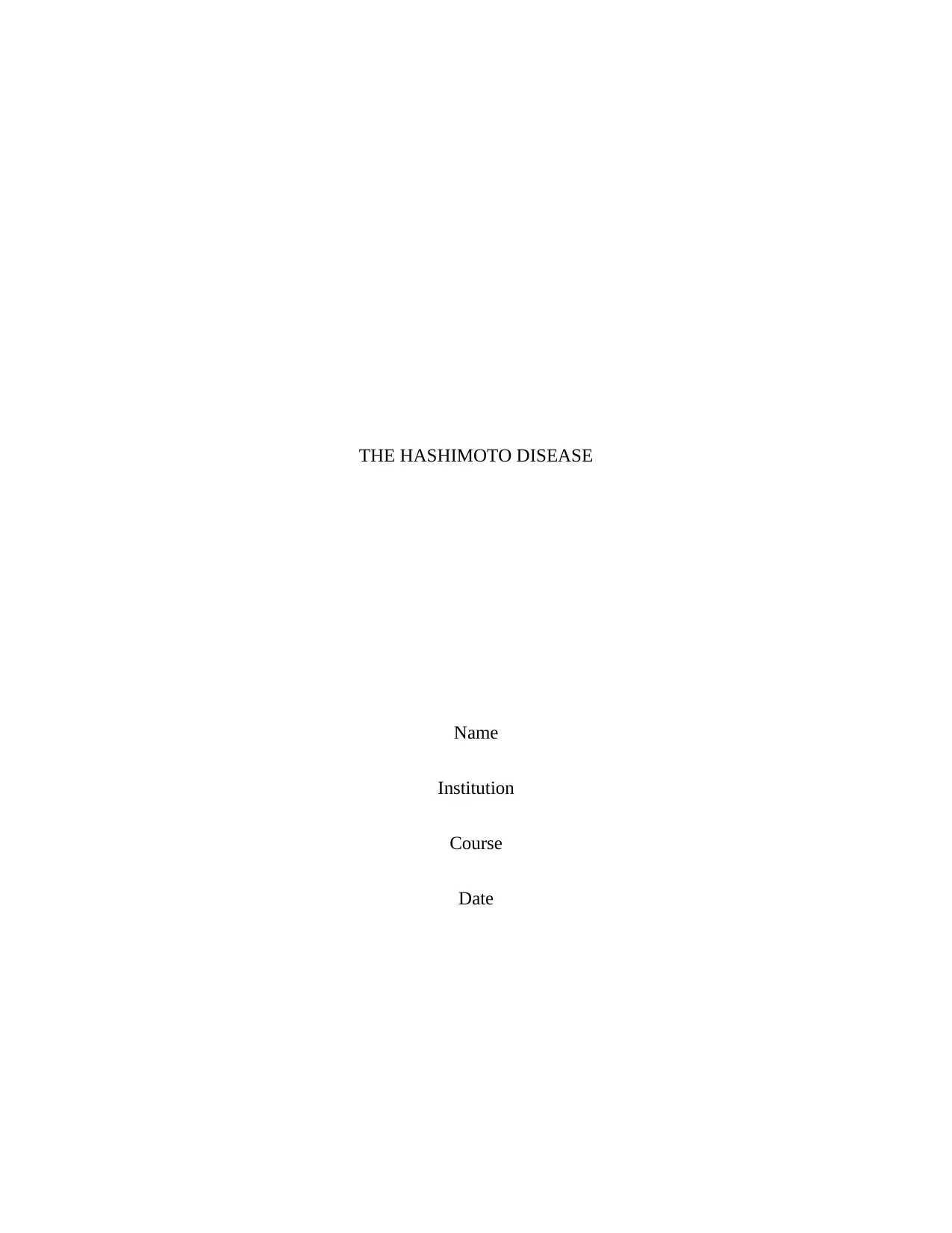
THE HASHIMOTO DISEASE
Name
Institution
Course
Date
Name
Institution
Course
Date
Secure Best Marks with AI Grader
Need help grading? Try our AI Grader for instant feedback on your assignments.
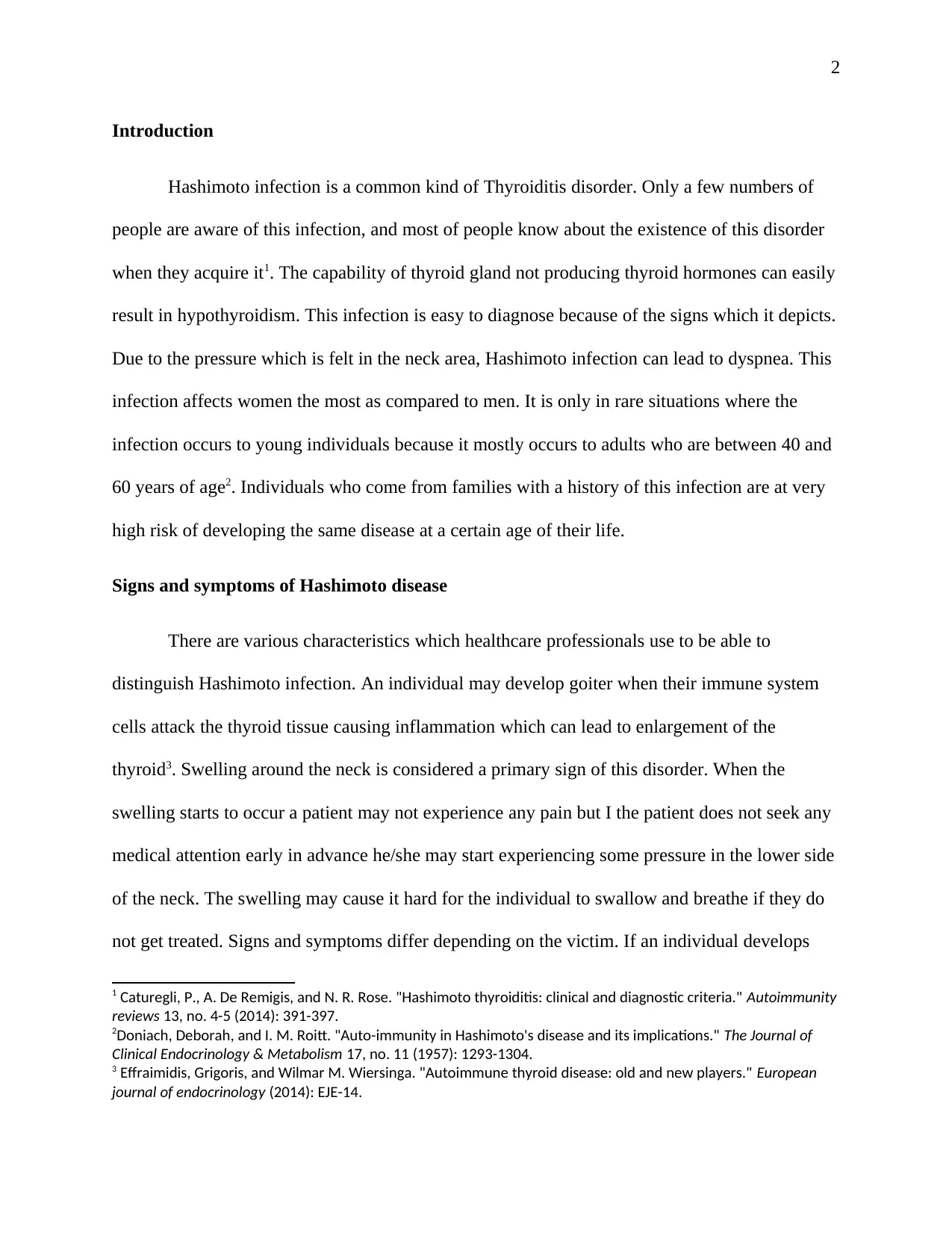
2
Introduction
Hashimoto infection is a common kind of Thyroiditis disorder. Only a few numbers of
people are aware of this infection, and most of people know about the existence of this disorder
when they acquire it1. The capability of thyroid gland not producing thyroid hormones can easily
result in hypothyroidism. This infection is easy to diagnose because of the signs which it depicts.
Due to the pressure which is felt in the neck area, Hashimoto infection can lead to dyspnea. This
infection affects women the most as compared to men. It is only in rare situations where the
infection occurs to young individuals because it mostly occurs to adults who are between 40 and
60 years of age2. Individuals who come from families with a history of this infection are at very
high risk of developing the same disease at a certain age of their life.
Signs and symptoms of Hashimoto disease
There are various characteristics which healthcare professionals use to be able to
distinguish Hashimoto infection. An individual may develop goiter when their immune system
cells attack the thyroid tissue causing inflammation which can lead to enlargement of the
thyroid3. Swelling around the neck is considered a primary sign of this disorder. When the
swelling starts to occur a patient may not experience any pain but I the patient does not seek any
medical attention early in advance he/she may start experiencing some pressure in the lower side
of the neck. The swelling may cause it hard for the individual to swallow and breathe if they do
not get treated. Signs and symptoms differ depending on the victim. If an individual develops
1 Caturegli, P., A. De Remigis, and N. R. Rose. "Hashimoto thyroiditis: clinical and diagnostic criteria." Autoimmunity
reviews 13, no. 4-5 (2014): 391-397.
2Doniach, Deborah, and I. M. Roitt. "Auto-immunity in Hashimoto's disease and its implications." The Journal of
Clinical Endocrinology & Metabolism 17, no. 11 (1957): 1293-1304.
3 Effraimidis, Grigoris, and Wilmar M. Wiersinga. "Autoimmune thyroid disease: old and new players." European
journal of endocrinology (2014): EJE-14.
Introduction
Hashimoto infection is a common kind of Thyroiditis disorder. Only a few numbers of
people are aware of this infection, and most of people know about the existence of this disorder
when they acquire it1. The capability of thyroid gland not producing thyroid hormones can easily
result in hypothyroidism. This infection is easy to diagnose because of the signs which it depicts.
Due to the pressure which is felt in the neck area, Hashimoto infection can lead to dyspnea. This
infection affects women the most as compared to men. It is only in rare situations where the
infection occurs to young individuals because it mostly occurs to adults who are between 40 and
60 years of age2. Individuals who come from families with a history of this infection are at very
high risk of developing the same disease at a certain age of their life.
Signs and symptoms of Hashimoto disease
There are various characteristics which healthcare professionals use to be able to
distinguish Hashimoto infection. An individual may develop goiter when their immune system
cells attack the thyroid tissue causing inflammation which can lead to enlargement of the
thyroid3. Swelling around the neck is considered a primary sign of this disorder. When the
swelling starts to occur a patient may not experience any pain but I the patient does not seek any
medical attention early in advance he/she may start experiencing some pressure in the lower side
of the neck. The swelling may cause it hard for the individual to swallow and breathe if they do
not get treated. Signs and symptoms differ depending on the victim. If an individual develops
1 Caturegli, P., A. De Remigis, and N. R. Rose. "Hashimoto thyroiditis: clinical and diagnostic criteria." Autoimmunity
reviews 13, no. 4-5 (2014): 391-397.
2Doniach, Deborah, and I. M. Roitt. "Auto-immunity in Hashimoto's disease and its implications." The Journal of
Clinical Endocrinology & Metabolism 17, no. 11 (1957): 1293-1304.
3 Effraimidis, Grigoris, and Wilmar M. Wiersinga. "Autoimmune thyroid disease: old and new players." European
journal of endocrinology (2014): EJE-14.
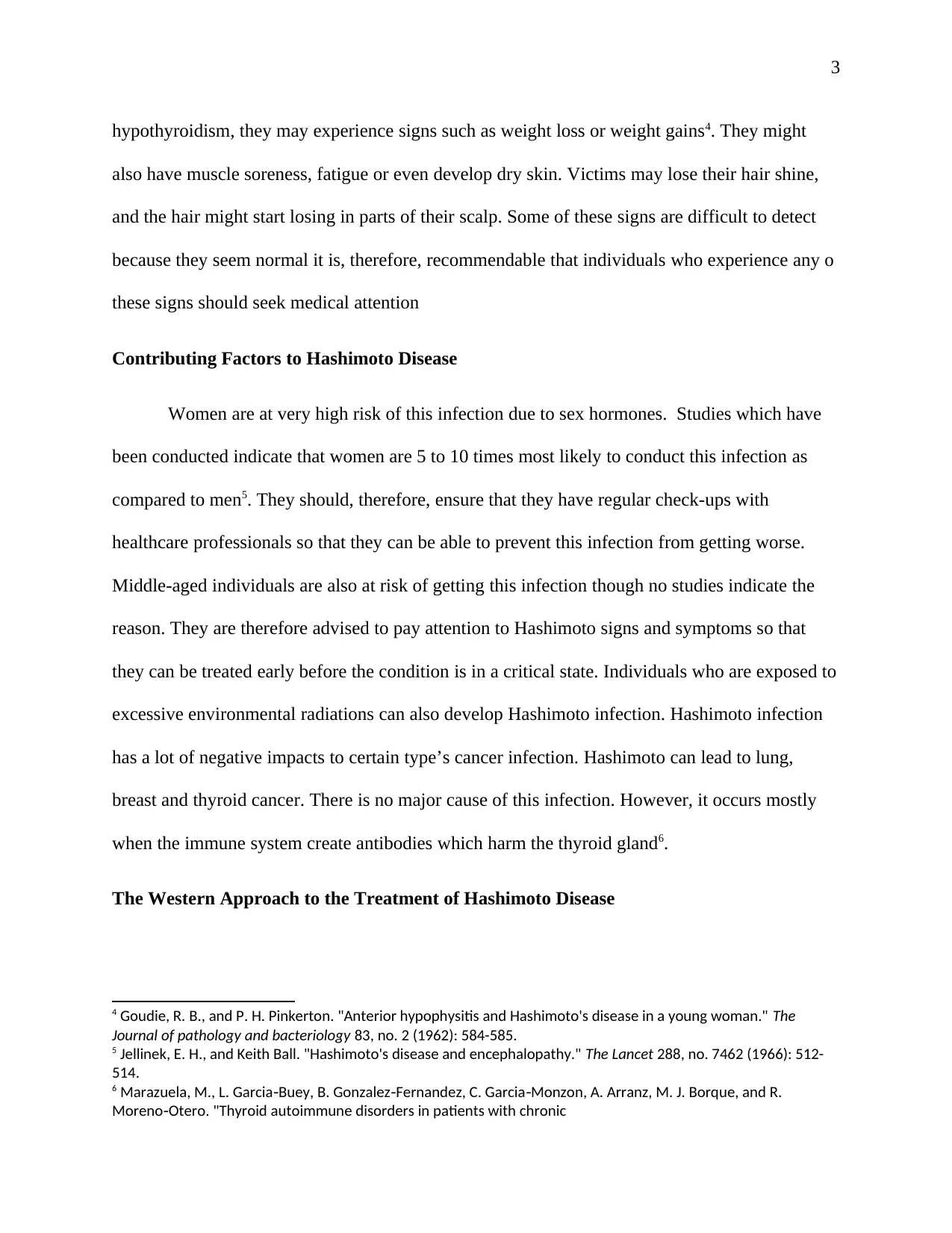
3
hypothyroidism, they may experience signs such as weight loss or weight gains4. They might
also have muscle soreness, fatigue or even develop dry skin. Victims may lose their hair shine,
and the hair might start losing in parts of their scalp. Some of these signs are difficult to detect
because they seem normal it is, therefore, recommendable that individuals who experience any o
these signs should seek medical attention
Contributing Factors to Hashimoto Disease
Women are at very high risk of this infection due to sex hormones. Studies which have
been conducted indicate that women are 5 to 10 times most likely to conduct this infection as
compared to men5. They should, therefore, ensure that they have regular check-ups with
healthcare professionals so that they can be able to prevent this infection from getting worse.
Middle-aged individuals are also at risk of getting this infection though no studies indicate the
reason. They are therefore advised to pay attention to Hashimoto signs and symptoms so that
they can be treated early before the condition is in a critical state. Individuals who are exposed to
excessive environmental radiations can also develop Hashimoto infection. Hashimoto infection
has a lot of negative impacts to certain type’s cancer infection. Hashimoto can lead to lung,
breast and thyroid cancer. There is no major cause of this infection. However, it occurs mostly
when the immune system create antibodies which harm the thyroid gland6.
The Western Approach to the Treatment of Hashimoto Disease
4 Goudie, R. B., and P. H. Pinkerton. "Anterior hypophysitis and Hashimoto's disease in a young woman." The
Journal of pathology and bacteriology 83, no. 2 (1962): 584-585.
5 Jellinek, E. H., and Keith Ball. "Hashimoto's disease and encephalopathy." The Lancet 288, no. 7462 (1966): 512-
514.
6 Marazuela, M., L. Garcia Buey, B. Gonzalez Fernandez, C. Garcia Monzon, A. Arranz, M. J. Borque, and R.‐ ‐ ‐
Moreno Otero. "Thyroid autoimmune disorders in patients with chronic‐
hypothyroidism, they may experience signs such as weight loss or weight gains4. They might
also have muscle soreness, fatigue or even develop dry skin. Victims may lose their hair shine,
and the hair might start losing in parts of their scalp. Some of these signs are difficult to detect
because they seem normal it is, therefore, recommendable that individuals who experience any o
these signs should seek medical attention
Contributing Factors to Hashimoto Disease
Women are at very high risk of this infection due to sex hormones. Studies which have
been conducted indicate that women are 5 to 10 times most likely to conduct this infection as
compared to men5. They should, therefore, ensure that they have regular check-ups with
healthcare professionals so that they can be able to prevent this infection from getting worse.
Middle-aged individuals are also at risk of getting this infection though no studies indicate the
reason. They are therefore advised to pay attention to Hashimoto signs and symptoms so that
they can be treated early before the condition is in a critical state. Individuals who are exposed to
excessive environmental radiations can also develop Hashimoto infection. Hashimoto infection
has a lot of negative impacts to certain type’s cancer infection. Hashimoto can lead to lung,
breast and thyroid cancer. There is no major cause of this infection. However, it occurs mostly
when the immune system create antibodies which harm the thyroid gland6.
The Western Approach to the Treatment of Hashimoto Disease
4 Goudie, R. B., and P. H. Pinkerton. "Anterior hypophysitis and Hashimoto's disease in a young woman." The
Journal of pathology and bacteriology 83, no. 2 (1962): 584-585.
5 Jellinek, E. H., and Keith Ball. "Hashimoto's disease and encephalopathy." The Lancet 288, no. 7462 (1966): 512-
514.
6 Marazuela, M., L. Garcia Buey, B. Gonzalez Fernandez, C. Garcia Monzon, A. Arranz, M. J. Borque, and R.‐ ‐ ‐
Moreno Otero. "Thyroid autoimmune disorders in patients with chronic‐
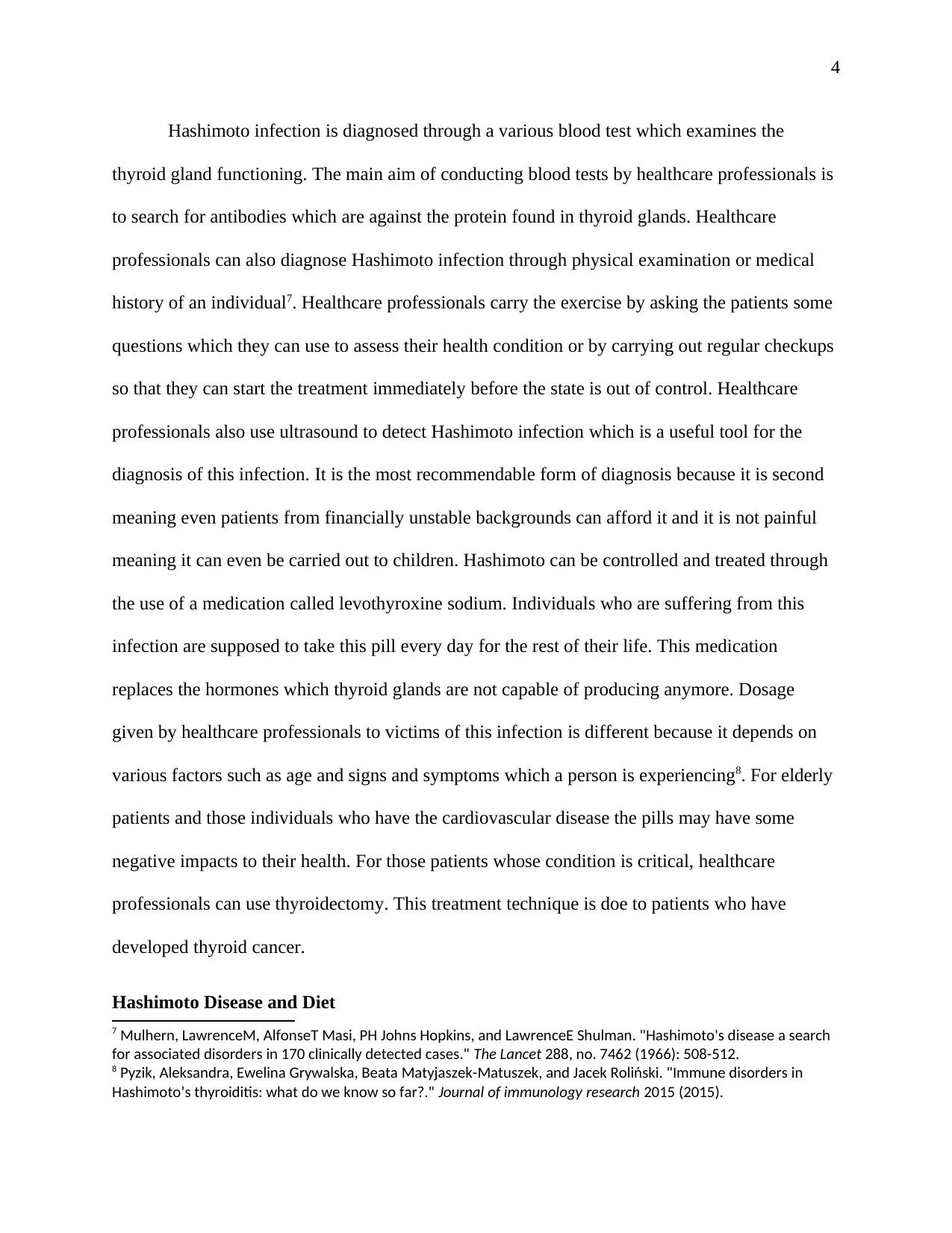
4
Hashimoto infection is diagnosed through a various blood test which examines the
thyroid gland functioning. The main aim of conducting blood tests by healthcare professionals is
to search for antibodies which are against the protein found in thyroid glands. Healthcare
professionals can also diagnose Hashimoto infection through physical examination or medical
history of an individual7. Healthcare professionals carry the exercise by asking the patients some
questions which they can use to assess their health condition or by carrying out regular checkups
so that they can start the treatment immediately before the state is out of control. Healthcare
professionals also use ultrasound to detect Hashimoto infection which is a useful tool for the
diagnosis of this infection. It is the most recommendable form of diagnosis because it is second
meaning even patients from financially unstable backgrounds can afford it and it is not painful
meaning it can even be carried out to children. Hashimoto can be controlled and treated through
the use of a medication called levothyroxine sodium. Individuals who are suffering from this
infection are supposed to take this pill every day for the rest of their life. This medication
replaces the hormones which thyroid glands are not capable of producing anymore. Dosage
given by healthcare professionals to victims of this infection is different because it depends on
various factors such as age and signs and symptoms which a person is experiencing8. For elderly
patients and those individuals who have the cardiovascular disease the pills may have some
negative impacts to their health. For those patients whose condition is critical, healthcare
professionals can use thyroidectomy. This treatment technique is doe to patients who have
developed thyroid cancer.
Hashimoto Disease and Diet
7 Mulhern, LawrenceM, AlfonseT Masi, PH Johns Hopkins, and LawrenceE Shulman. "Hashimoto's disease a search
for associated disorders in 170 clinically detected cases." The Lancet 288, no. 7462 (1966): 508-512.
8 Pyzik, Aleksandra, Ewelina Grywalska, Beata Matyjaszek-Matuszek, and Jacek Roliński. "Immune disorders in
Hashimoto’s thyroiditis: what do we know so far?." Journal of immunology research 2015 (2015).
Hashimoto infection is diagnosed through a various blood test which examines the
thyroid gland functioning. The main aim of conducting blood tests by healthcare professionals is
to search for antibodies which are against the protein found in thyroid glands. Healthcare
professionals can also diagnose Hashimoto infection through physical examination or medical
history of an individual7. Healthcare professionals carry the exercise by asking the patients some
questions which they can use to assess their health condition or by carrying out regular checkups
so that they can start the treatment immediately before the state is out of control. Healthcare
professionals also use ultrasound to detect Hashimoto infection which is a useful tool for the
diagnosis of this infection. It is the most recommendable form of diagnosis because it is second
meaning even patients from financially unstable backgrounds can afford it and it is not painful
meaning it can even be carried out to children. Hashimoto can be controlled and treated through
the use of a medication called levothyroxine sodium. Individuals who are suffering from this
infection are supposed to take this pill every day for the rest of their life. This medication
replaces the hormones which thyroid glands are not capable of producing anymore. Dosage
given by healthcare professionals to victims of this infection is different because it depends on
various factors such as age and signs and symptoms which a person is experiencing8. For elderly
patients and those individuals who have the cardiovascular disease the pills may have some
negative impacts to their health. For those patients whose condition is critical, healthcare
professionals can use thyroidectomy. This treatment technique is doe to patients who have
developed thyroid cancer.
Hashimoto Disease and Diet
7 Mulhern, LawrenceM, AlfonseT Masi, PH Johns Hopkins, and LawrenceE Shulman. "Hashimoto's disease a search
for associated disorders in 170 clinically detected cases." The Lancet 288, no. 7462 (1966): 508-512.
8 Pyzik, Aleksandra, Ewelina Grywalska, Beata Matyjaszek-Matuszek, and Jacek Roliński. "Immune disorders in
Hashimoto’s thyroiditis: what do we know so far?." Journal of immunology research 2015 (2015).
Secure Best Marks with AI Grader
Need help grading? Try our AI Grader for instant feedback on your assignments.
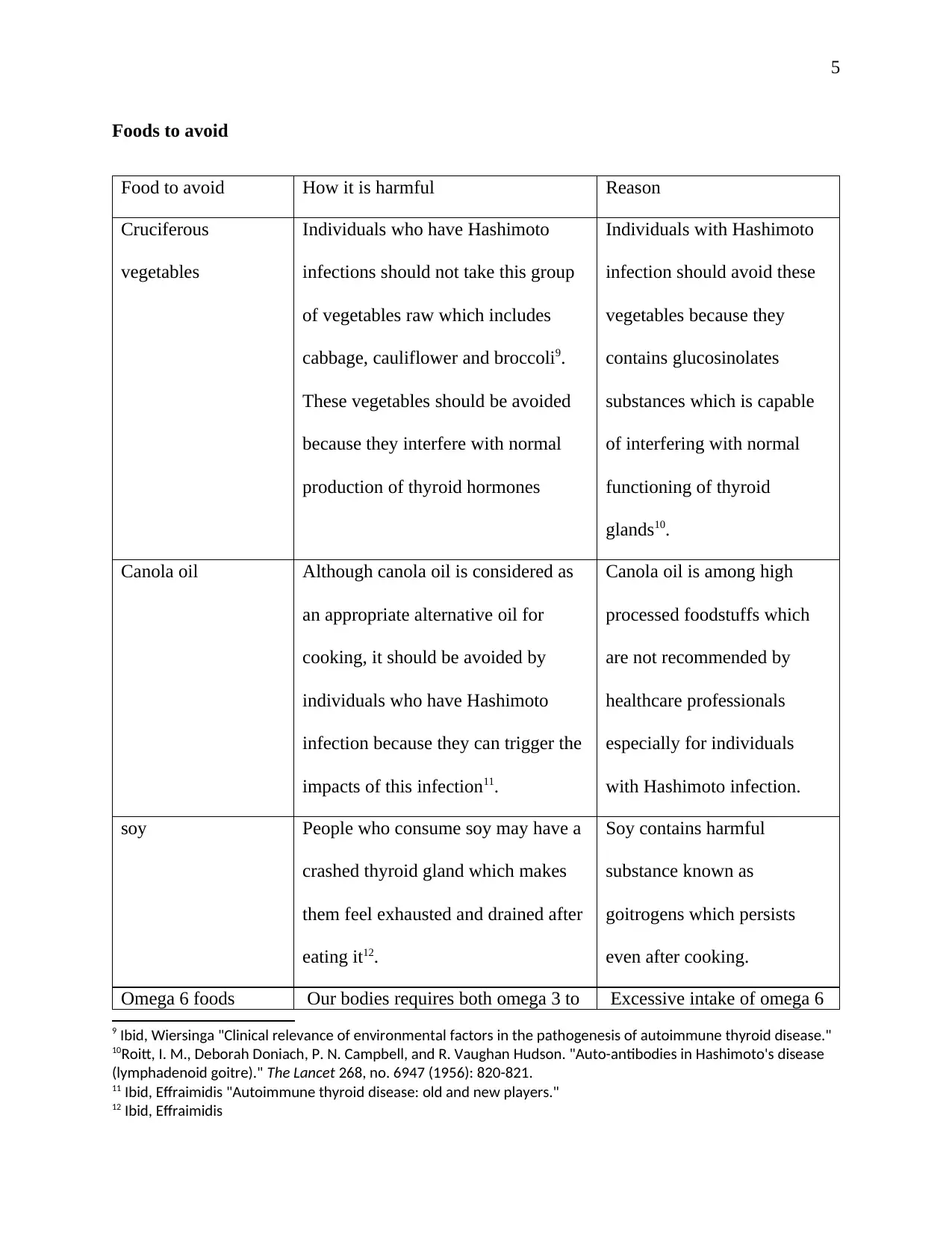
5
Foods to avoid
Food to avoid How it is harmful Reason
Cruciferous
vegetables
Individuals who have Hashimoto
infections should not take this group
of vegetables raw which includes
cabbage, cauliflower and broccoli9.
These vegetables should be avoided
because they interfere with normal
production of thyroid hormones
Individuals with Hashimoto
infection should avoid these
vegetables because they
contains glucosinolates
substances which is capable
of interfering with normal
functioning of thyroid
glands10.
Canola oil Although canola oil is considered as
an appropriate alternative oil for
cooking, it should be avoided by
individuals who have Hashimoto
infection because they can trigger the
impacts of this infection11.
Canola oil is among high
processed foodstuffs which
are not recommended by
healthcare professionals
especially for individuals
with Hashimoto infection.
soy People who consume soy may have a
crashed thyroid gland which makes
them feel exhausted and drained after
eating it12.
Soy contains harmful
substance known as
goitrogens which persists
even after cooking.
Omega 6 foods Our bodies requires both omega 3 to Excessive intake of omega 6
9 Ibid, Wiersinga "Clinical relevance of environmental factors in the pathogenesis of autoimmune thyroid disease."
10Roitt, I. M., Deborah Doniach, P. N. Campbell, and R. Vaughan Hudson. "Auto-antibodies in Hashimoto's disease
(lymphadenoid goitre)." The Lancet 268, no. 6947 (1956): 820-821.
11 Ibid, Effraimidis "Autoimmune thyroid disease: old and new players."
12 Ibid, Effraimidis
Foods to avoid
Food to avoid How it is harmful Reason
Cruciferous
vegetables
Individuals who have Hashimoto
infections should not take this group
of vegetables raw which includes
cabbage, cauliflower and broccoli9.
These vegetables should be avoided
because they interfere with normal
production of thyroid hormones
Individuals with Hashimoto
infection should avoid these
vegetables because they
contains glucosinolates
substances which is capable
of interfering with normal
functioning of thyroid
glands10.
Canola oil Although canola oil is considered as
an appropriate alternative oil for
cooking, it should be avoided by
individuals who have Hashimoto
infection because they can trigger the
impacts of this infection11.
Canola oil is among high
processed foodstuffs which
are not recommended by
healthcare professionals
especially for individuals
with Hashimoto infection.
soy People who consume soy may have a
crashed thyroid gland which makes
them feel exhausted and drained after
eating it12.
Soy contains harmful
substance known as
goitrogens which persists
even after cooking.
Omega 6 foods Our bodies requires both omega 3 to Excessive intake of omega 6
9 Ibid, Wiersinga "Clinical relevance of environmental factors in the pathogenesis of autoimmune thyroid disease."
10Roitt, I. M., Deborah Doniach, P. N. Campbell, and R. Vaughan Hudson. "Auto-antibodies in Hashimoto's disease
(lymphadenoid goitre)." The Lancet 268, no. 6947 (1956): 820-821.
11 Ibid, Effraimidis "Autoimmune thyroid disease: old and new players."
12 Ibid, Effraimidis

6
reduce inflammation and omega 6 to
promote inflammation. However,
excessive consumption of omega 6
for individuals with Hashimoto can
affect the normal functioning of
thyroid gland13.
should be avoided because
they contain substance which
can be harmful to the victim’s
body by interfering with
thyroid gland
Gluten Gluten is capable of increasing
intestinal permeability which can lead
to a condition referred to as leaky gut
by healthcare professionals14.
Patients who have Hashimoto
infection are most likely to
have some degree of gluten
intolerance. It is therefore
advisable that they should
eliminate gluten from their
diets.
Foods to eat
Foods to eat Key nutrients Reason
Seaweed and sea vegetables Sea vegetables have contains
iodine nutrients15.
The iodine nutrients which is
found in seaweeds an
vegetables is absorbed in the
body to enable thyroid gland
13 Wiersinga, Wilmar M. "Clinical relevance of environmental factors in the pathogenesis of autoimmune thyroid
disease." Endocrinology and Metabolism 31, no. 2 (2016): 213-222.
14 Ibid, Goudie "Anterior hypophysitis and Hashimoto's disease in a young woman."
15 Ibid, Caturegli.
reduce inflammation and omega 6 to
promote inflammation. However,
excessive consumption of omega 6
for individuals with Hashimoto can
affect the normal functioning of
thyroid gland13.
should be avoided because
they contain substance which
can be harmful to the victim’s
body by interfering with
thyroid gland
Gluten Gluten is capable of increasing
intestinal permeability which can lead
to a condition referred to as leaky gut
by healthcare professionals14.
Patients who have Hashimoto
infection are most likely to
have some degree of gluten
intolerance. It is therefore
advisable that they should
eliminate gluten from their
diets.
Foods to eat
Foods to eat Key nutrients Reason
Seaweed and sea vegetables Sea vegetables have contains
iodine nutrients15.
The iodine nutrients which is
found in seaweeds an
vegetables is absorbed in the
body to enable thyroid gland
13 Wiersinga, Wilmar M. "Clinical relevance of environmental factors in the pathogenesis of autoimmune thyroid
disease." Endocrinology and Metabolism 31, no. 2 (2016): 213-222.
14 Ibid, Goudie "Anterior hypophysitis and Hashimoto's disease in a young woman."
15 Ibid, Caturegli.
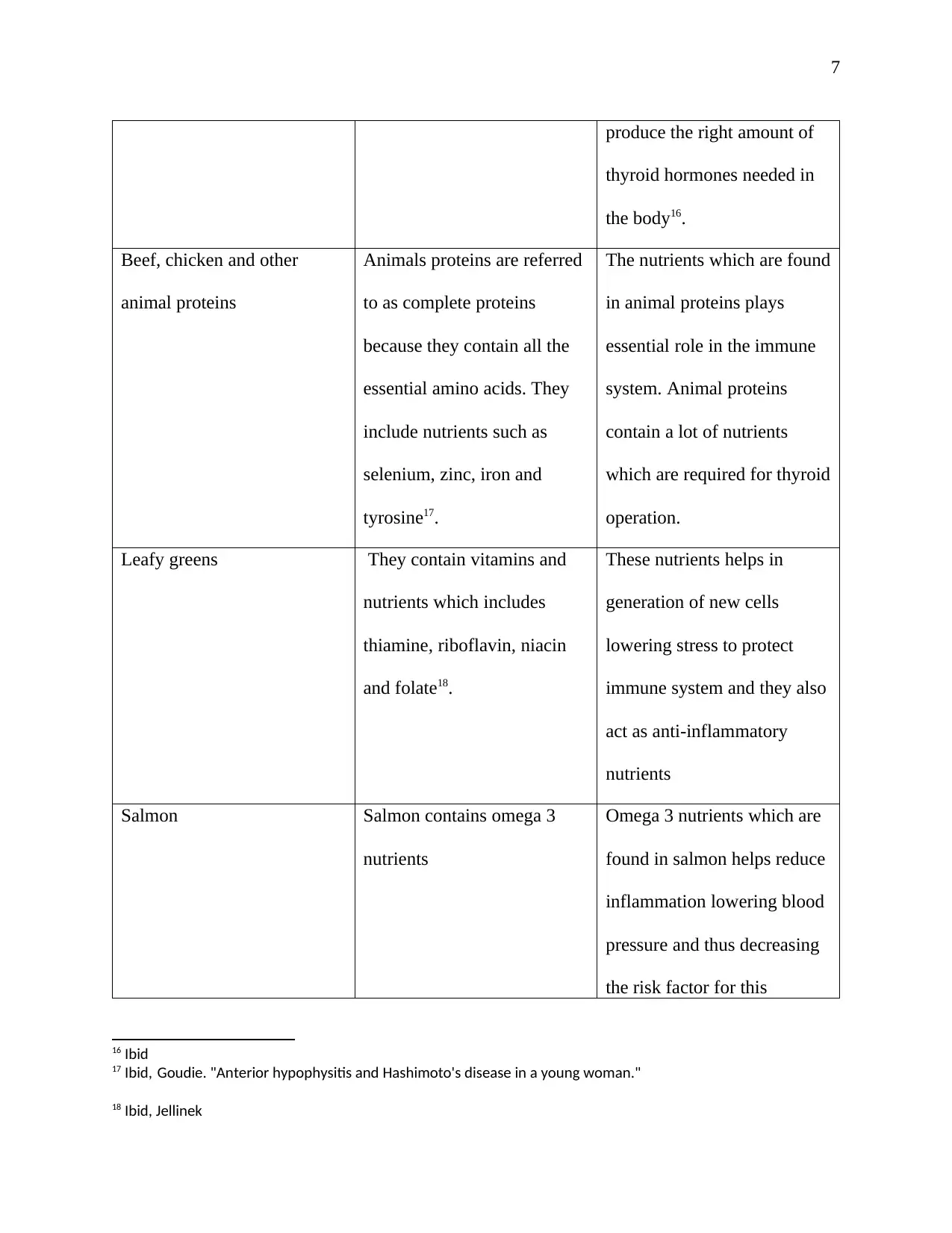
7
produce the right amount of
thyroid hormones needed in
the body16.
Beef, chicken and other
animal proteins
Animals proteins are referred
to as complete proteins
because they contain all the
essential amino acids. They
include nutrients such as
selenium, zinc, iron and
tyrosine17.
The nutrients which are found
in animal proteins plays
essential role in the immune
system. Animal proteins
contain a lot of nutrients
which are required for thyroid
operation.
Leafy greens They contain vitamins and
nutrients which includes
thiamine, riboflavin, niacin
and folate18.
These nutrients helps in
generation of new cells
lowering stress to protect
immune system and they also
act as anti-inflammatory
nutrients
Salmon Salmon contains omega 3
nutrients
Omega 3 nutrients which are
found in salmon helps reduce
inflammation lowering blood
pressure and thus decreasing
the risk factor for this
16 Ibid
17 Ibid, Goudie. "Anterior hypophysitis and Hashimoto's disease in a young woman."
18 Ibid, Jellinek
produce the right amount of
thyroid hormones needed in
the body16.
Beef, chicken and other
animal proteins
Animals proteins are referred
to as complete proteins
because they contain all the
essential amino acids. They
include nutrients such as
selenium, zinc, iron and
tyrosine17.
The nutrients which are found
in animal proteins plays
essential role in the immune
system. Animal proteins
contain a lot of nutrients
which are required for thyroid
operation.
Leafy greens They contain vitamins and
nutrients which includes
thiamine, riboflavin, niacin
and folate18.
These nutrients helps in
generation of new cells
lowering stress to protect
immune system and they also
act as anti-inflammatory
nutrients
Salmon Salmon contains omega 3
nutrients
Omega 3 nutrients which are
found in salmon helps reduce
inflammation lowering blood
pressure and thus decreasing
the risk factor for this
16 Ibid
17 Ibid, Goudie. "Anterior hypophysitis and Hashimoto's disease in a young woman."
18 Ibid, Jellinek
Paraphrase This Document
Need a fresh take? Get an instant paraphrase of this document with our AI Paraphraser

8
infection
avocado Avocado contains nutrients
such as vitamin B, iron, zinc
and folate.
Healthcare professionals
recommends patients
suffering from Hashimoto to
include avocado in their diet
because they contain 77% of
fats which are anti-
inflammatory in nature19.
Summary
Hashimoto is a life-threatening infection across the globe. This is because most people
are not aware of the infection because its signs and symptoms appear normal. Individuals are
therefore advised to ensure that they seek medical attention more regularly for checkups so that
healthcare professionals can be able to control and treat this infection early in advance. If
individual experience signs as difficulties in breathing and swallowing as well as drastic weight
loss or gain they should seek assistance from healthcare professionals so that they can be able to
19 Ibid
infection
avocado Avocado contains nutrients
such as vitamin B, iron, zinc
and folate.
Healthcare professionals
recommends patients
suffering from Hashimoto to
include avocado in their diet
because they contain 77% of
fats which are anti-
inflammatory in nature19.
Summary
Hashimoto is a life-threatening infection across the globe. This is because most people
are not aware of the infection because its signs and symptoms appear normal. Individuals are
therefore advised to ensure that they seek medical attention more regularly for checkups so that
healthcare professionals can be able to control and treat this infection early in advance. If
individual experience signs as difficulties in breathing and swallowing as well as drastic weight
loss or gain they should seek assistance from healthcare professionals so that they can be able to
19 Ibid
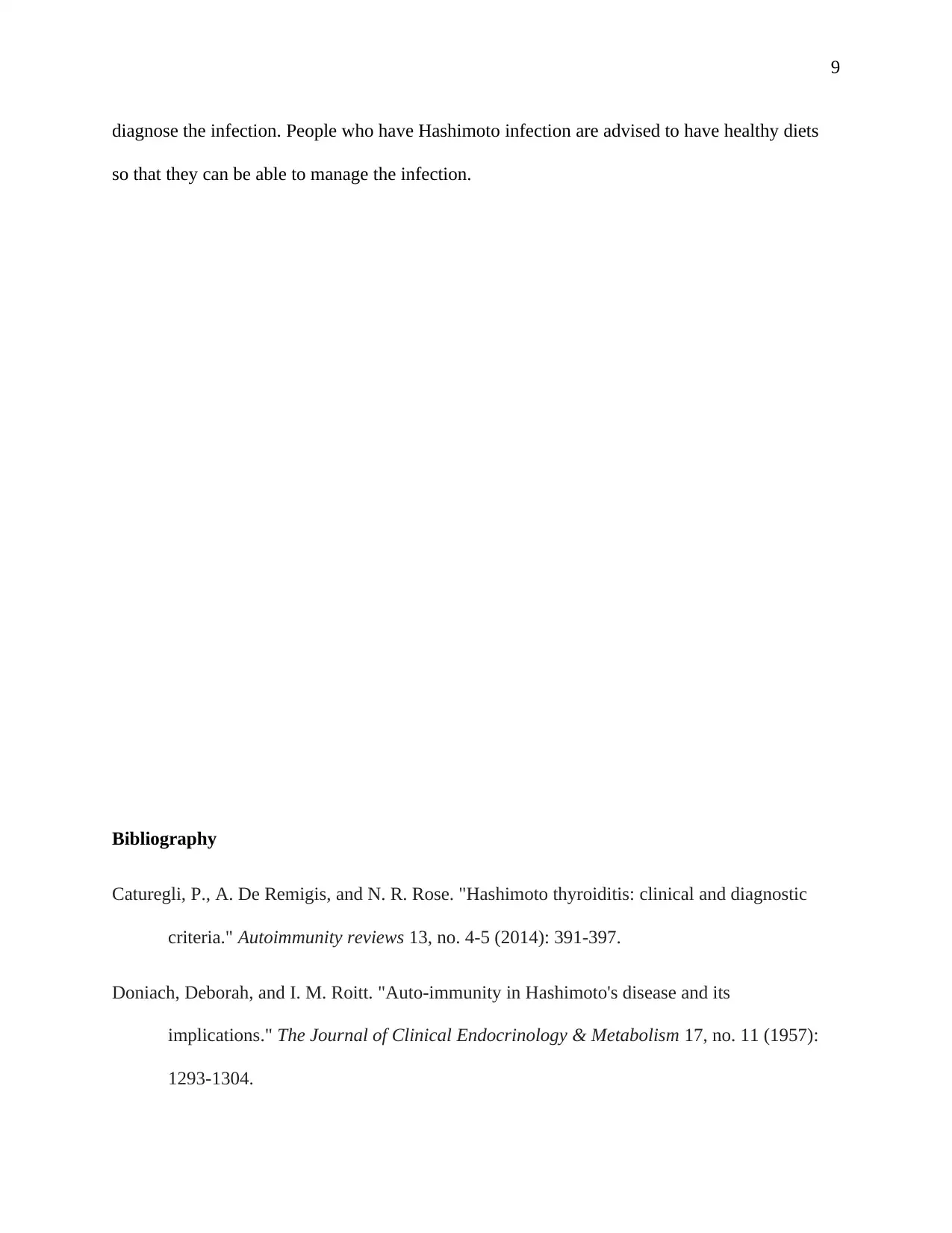
9
diagnose the infection. People who have Hashimoto infection are advised to have healthy diets
so that they can be able to manage the infection.
Bibliography
Caturegli, P., A. De Remigis, and N. R. Rose. "Hashimoto thyroiditis: clinical and diagnostic
criteria." Autoimmunity reviews 13, no. 4-5 (2014): 391-397.
Doniach, Deborah, and I. M. Roitt. "Auto-immunity in Hashimoto's disease and its
implications." The Journal of Clinical Endocrinology & Metabolism 17, no. 11 (1957):
1293-1304.
diagnose the infection. People who have Hashimoto infection are advised to have healthy diets
so that they can be able to manage the infection.
Bibliography
Caturegli, P., A. De Remigis, and N. R. Rose. "Hashimoto thyroiditis: clinical and diagnostic
criteria." Autoimmunity reviews 13, no. 4-5 (2014): 391-397.
Doniach, Deborah, and I. M. Roitt. "Auto-immunity in Hashimoto's disease and its
implications." The Journal of Clinical Endocrinology & Metabolism 17, no. 11 (1957):
1293-1304.
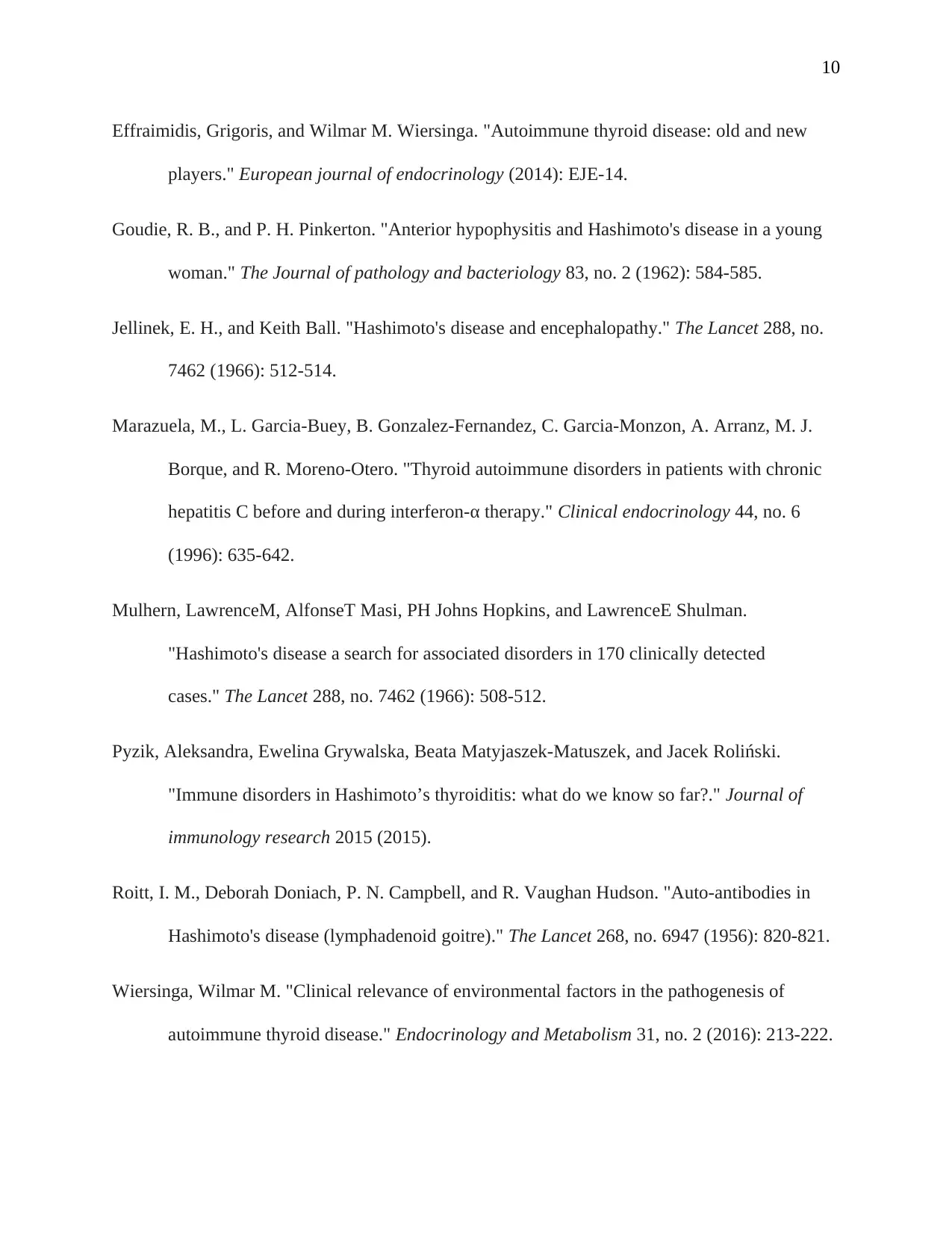
10
Effraimidis, Grigoris, and Wilmar M. Wiersinga. "Autoimmune thyroid disease: old and new
players." European journal of endocrinology (2014): EJE-14.
Goudie, R. B., and P. H. Pinkerton. "Anterior hypophysitis and Hashimoto's disease in a young
woman." The Journal of pathology and bacteriology 83, no. 2 (1962): 584-585.
Jellinek, E. H., and Keith Ball. "Hashimoto's disease and encephalopathy." The Lancet 288, no.
7462 (1966): 512-514.
Marazuela, M., L. Garcia‐Buey, B. Gonzalez‐Fernandez, C. Garcia‐Monzon, A. Arranz, M. J.
Borque, and R. Moreno‐Otero. "Thyroid autoimmune disorders in patients with chronic
hepatitis C before and during interferon‐α therapy." Clinical endocrinology 44, no. 6
(1996): 635-642.
Mulhern, LawrenceM, AlfonseT Masi, PH Johns Hopkins, and LawrenceE Shulman.
"Hashimoto's disease a search for associated disorders in 170 clinically detected
cases." The Lancet 288, no. 7462 (1966): 508-512.
Pyzik, Aleksandra, Ewelina Grywalska, Beata Matyjaszek-Matuszek, and Jacek Roliński.
"Immune disorders in Hashimoto’s thyroiditis: what do we know so far?." Journal of
immunology research 2015 (2015).
Roitt, I. M., Deborah Doniach, P. N. Campbell, and R. Vaughan Hudson. "Auto-antibodies in
Hashimoto's disease (lymphadenoid goitre)." The Lancet 268, no. 6947 (1956): 820-821.
Wiersinga, Wilmar M. "Clinical relevance of environmental factors in the pathogenesis of
autoimmune thyroid disease." Endocrinology and Metabolism 31, no. 2 (2016): 213-222.
Effraimidis, Grigoris, and Wilmar M. Wiersinga. "Autoimmune thyroid disease: old and new
players." European journal of endocrinology (2014): EJE-14.
Goudie, R. B., and P. H. Pinkerton. "Anterior hypophysitis and Hashimoto's disease in a young
woman." The Journal of pathology and bacteriology 83, no. 2 (1962): 584-585.
Jellinek, E. H., and Keith Ball. "Hashimoto's disease and encephalopathy." The Lancet 288, no.
7462 (1966): 512-514.
Marazuela, M., L. Garcia‐Buey, B. Gonzalez‐Fernandez, C. Garcia‐Monzon, A. Arranz, M. J.
Borque, and R. Moreno‐Otero. "Thyroid autoimmune disorders in patients with chronic
hepatitis C before and during interferon‐α therapy." Clinical endocrinology 44, no. 6
(1996): 635-642.
Mulhern, LawrenceM, AlfonseT Masi, PH Johns Hopkins, and LawrenceE Shulman.
"Hashimoto's disease a search for associated disorders in 170 clinically detected
cases." The Lancet 288, no. 7462 (1966): 508-512.
Pyzik, Aleksandra, Ewelina Grywalska, Beata Matyjaszek-Matuszek, and Jacek Roliński.
"Immune disorders in Hashimoto’s thyroiditis: what do we know so far?." Journal of
immunology research 2015 (2015).
Roitt, I. M., Deborah Doniach, P. N. Campbell, and R. Vaughan Hudson. "Auto-antibodies in
Hashimoto's disease (lymphadenoid goitre)." The Lancet 268, no. 6947 (1956): 820-821.
Wiersinga, Wilmar M. "Clinical relevance of environmental factors in the pathogenesis of
autoimmune thyroid disease." Endocrinology and Metabolism 31, no. 2 (2016): 213-222.
Secure Best Marks with AI Grader
Need help grading? Try our AI Grader for instant feedback on your assignments.

11
1 out of 11
Related Documents
Your All-in-One AI-Powered Toolkit for Academic Success.
+13062052269
info@desklib.com
Available 24*7 on WhatsApp / Email
![[object Object]](/_next/static/media/star-bottom.7253800d.svg)
Unlock your academic potential
© 2024 | Zucol Services PVT LTD | All rights reserved.





